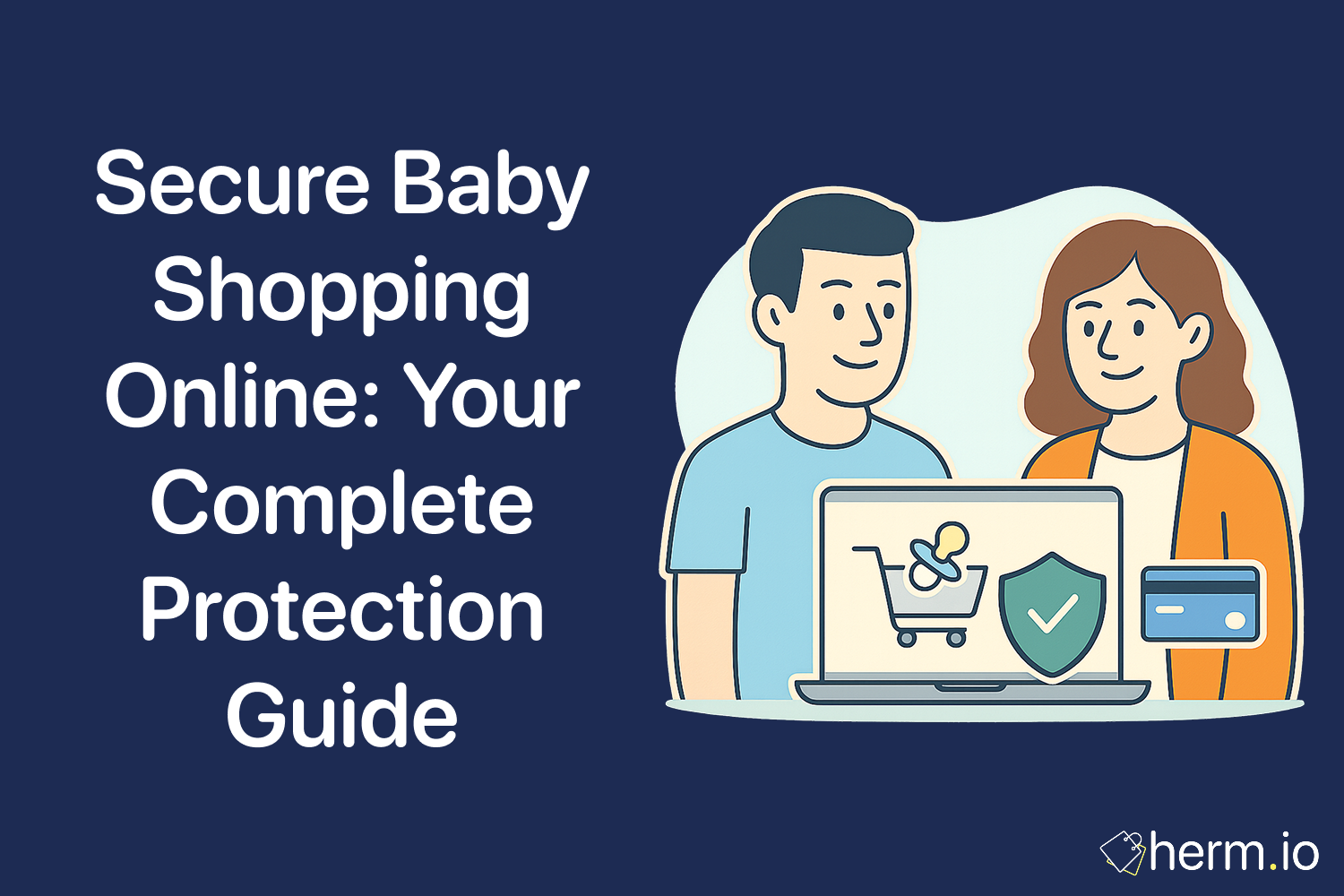
Picture this: you're browsing for baby products at 2am, exhausted from night feeds, desperately needing that perfect sleep solution. From a security perspective, this vulnerability makes you a prime target for counterfeit sellers and unsafe products. Building resilient shopping habits requires more than just finding the lowest price; you need systematic protection protocols that safeguard both your money and your baby's wellbeing.
Unlike standard online purchases, baby product shopping demands military-grade attention to safety credentials and seller verification. Think of it as creating digital armour around your most precious investment. This guide establishes the security framework every parent needs before clicking 'buy now'.
Quick Wins: Implement These Today to Start Shopping Securely
- Verify CE markings on all product listings before purchase
- Cross-reference seller ratings across multiple platforms
- Screenshot product specifications for future reference
- Set up automated price alerts instead of bulk buying
- Create a dedicated email for baby shopping to track orders
Building Your Safety Verification System
From a security perspective, baby product safety isn't negotiable. Every item requires thorough credential checking before it enters your home. The CE marking serves as your first line of defence against substandard products.
Decoding the CE Security Protocol
The CE marking functions like a digital passport for baby products sold within the European Economic Area. This isn't marketing fluff; it's mandatory compliance documentation that proves safety testing completion.
Here's your verification checklist:
- Locate the CE logo in product images or description text
- Download the Declaration of Conformity document when available
- Cross-check age recommendations against your baby's current development stage
- Scan material specifications for banned substances like BPA or phthalates
Missing CE documentation signals immediate risk. Legitimate manufacturers proudly display these credentials; their absence suggests corner-cutting or counterfeit products.
International Standard Cross-Referencing
Smart security practitioners never rely on single verification points. ASTM standards from the United States and CCC marks from China provide additional validation layers. Products carrying multiple certifications demonstrate manufacturers' commitment to global safety compliance.
Retailer Authentication Protocols
Building resilient shopping habits requires systematic seller evaluation. Not every online retailer maintains the same security standards or authenticity guarantees.
Brand Verification Framework
Start with established manufacturers like Chicco, Graco, and Tommee Tippee. These companies invest heavily in security protocols and supply chain transparency. Your verification process should include:
- Official website cross-referencing to confirm authorised seller status
- Independent review analysis across parent forums and consumer advocacy sites
- Recall history examination over the previous five-year period
Retailer Security Assessment
Even premium brands lose credibility through poor retailer partnerships. Evaluate each seller's operational security:
- Shipping protection guarantees for fragile baby equipment
- Customer service accessibility through multiple contact channels
- Authenticity verification policies with money-back guarantees
Counterfeit Detection Strategies
Marketplace platforms host numerous third-party sellers operating with varying integrity levels. Think of it as creating digital armour against fraudulent listings:
- Seller rating requirements: Target 4.8 stars minimum with extensive review history
- Image quality analysis: Professional photography suggests legitimate inventory
- Price reality checks: Dramatic discounts often indicate counterfeit or damaged goods
Smart Purchasing Architecture
The subscription economy and bulk buying promotions create false security through apparent savings. From a security perspective, overcommitment exposes you to inventory risks and financial waste.
Avoiding the Bundle Trap
Retailers package complementary items to increase transaction values, but bundles often contain unnecessary components. Your security protocol should include:
- Individual item price comparison against bundle pricing
- Component utility assessment based on your specific needs
- Return policy complexity for mixed-item packages
Just-in-Time Security Model
Think of it as creating digital armour against impulse purchasing and overstock risks. This approach reduces storage vulnerabilities while maintaining supply security:
- Trial quantity ordering for new products or brands
- Usage pattern monitoring over two-week periods
- Automated reorder scheduling based on consumption data
Growth Planning Security Framework
Baby development creates unique purchasing challenges through rapid size changes and product expiration dates. Building resilient shopping habits requires forward-thinking security measures.
Size Transition Protection
Each brand defines size categories differently, creating fitting uncertainties. Your security strategy should include:
- Size chart comparison across multiple manufacturer specifications
- Mixed-size purchasing to hedge against unexpected growth spurts
- Adjustable equipment prioritisation for long-term value protection
Expiration Date Security Protocol
Consumable baby products carry strict expiration requirements that directly impact safety. From a security perspective, date verification prevents health risks:
- Manufacturing date identification on all consumable purchases
- Shelf life calculation using manufacturer specifications
- Fresh stock filtering by selecting newest arrival options
Return Protection Strategies
Even with systematic planning, product incompatibilities occur. Strong return policies function as insurance against purchasing mistakes and defective items.
Return Window Documentation
Different retailers offer varying return periods and conditions. Think of it as creating digital armour for post-purchase protection:
- Return initiation methods: Online portals versus customer service requirements
- Shipping responsibility allocation: Free return labels versus customer cost responsibility
- Condition requirements: Original packaging versus opened product acceptance
Exchange Versus Refund Analysis
Strategic return planning can accelerate replacement timelines compared to refund waiting periods. Your security framework should evaluate:
- Model swap availability for size or feature adjustments
- Restocking fee structures on high-value items like car seats
- Return shipping cost allocation across different retailers
Subscription Service Security Assessment
Automated delivery services promise convenience but require careful security evaluation. Building resilient shopping habits means understanding subscription risks alongside benefits.
Subscription Advantage Analysis
From a security perspective, legitimate subscription services offer:
- Automated supply chain management preventing emergency shortage situations
- Personalisation algorithms matching products to developmental stages
- Bulk pricing security with consistent discount applications
Risk Mitigation Protocols
Subscription commitments create financial obligations that require protective measures:
- Flexible terms negotiation allowing pause or cancellation without penalties
- Content auditing systems to evaluate actual product utility
- Hybrid purchasing strategies combining subscriptions with one-off purchases
Frequently Asked Questions
How can I verify a baby product's safety credentials online?
Look for CE markings prominently displayed in product listings, then download the Declaration of Conformity document. Cross-reference with manufacturer websites to confirm authorised seller status. Legitimate retailers highlight safety certifications and provide accessible product manuals.
Which return policies offer the best protection for baby gear purchases?
Prioritise retailers offering 30-day minimum return windows with free return shipping labels. Avoid sellers charging restocking fees on safety equipment like car seats. Always verify whether opened consumables qualify for returns before purchasing.
Are baby subscription services worth the security risks?
Subscription services work well for consumables like nappies when they offer flexible terms without minimum commitments. Avoid services requiring six-month contracts or charging early cancellation fees. Monitor each delivery's utility rate; if you're using less than 70% of items, switch to individual purchasing.
What's the safest way to buy baby products from international sellers?
Stick to sellers within your regulatory jurisdiction to ensure safety standard compliance. If buying internationally, verify that products carry your local safety certifications (CE for EU, ASTM for US). Factor in potential customs duties and extended return shipping times when calculating true costs.
Building resilient shopping habits for baby products requires systematic security thinking rather than emotional purchasing decisions. From a security perspective, your baby's safety depends on verification protocols, seller authentication, and strategic purchasing frameworks.
Think of it as creating digital armour that protects both your family's wellbeing and your financial security. Each security measure builds upon the others, creating comprehensive protection against counterfeits, overpricing, and safety risks.
What security gap in your current baby shopping routine needs immediate attention?

Oliver James Whitmore
I'm a security expert specializing in privacy, systems architecture, and cybersecurity. With experience across startups and large enterprises, I build resilient, user-centric security systems. I bridge the gap between technical capabilities and business value, making complex systems both secure and adaptable.

.png)








.png)

.png)
.png)
.png)